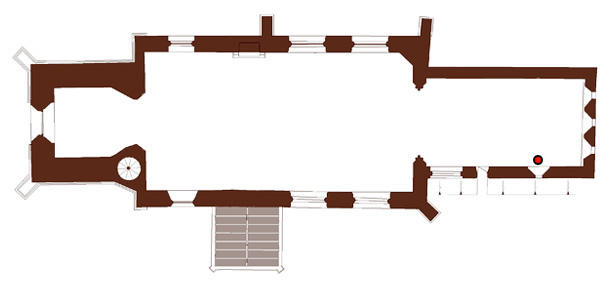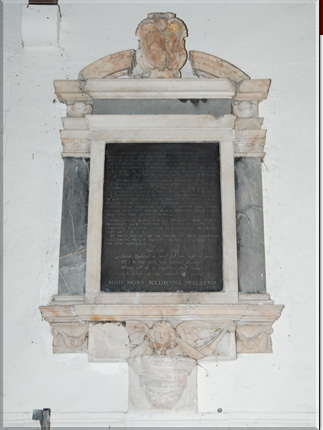Chancel South Wall

| William Slatholme d 1665 + Sennock Slatholme d 1662 Susanna Slatholme + Sarah Slatholme d 1665 |
To see what the numbers 1-10 of each memorial description are click here
- Rectangular black inscription tablet in an architectural frame headed by a scrolled carved and
painted armorial cartouche set between the arms of the broken segmental pediment. The
tinctures are much faded.
Blazon (Gules) on a chevron between three crosses crosslet (Or)
impaling
per pale (Azure and Gules) a saltire (Or) a martlet for difference
(ref a)
Above the shield is a winged cherub’s head. The stepped and moulded cornice is stepped back at each side where there is a winged cherub’s head on the plain grey frieze. A portion of the cornice on the W side is missing as is a portion of the stepped architrave at a point almost immediately below. The inscription is incised in white-filled roman caps and sloped caps and l/c using the long ess and archaic spelling. The e in the word Ye is placed in the arms of the Y. The tablet is in a plain white frame with roll moulded inner edge and is flanked by set back pilasters with grey veined shafts and white capitals and bases. The capitals are carved with egg and dart above a frieze of acanthus leaves. Beneath a stepped shelf which matches the architrave is a rectangular apron on which is a relief-carved winged cherub’s head. Swags are draped behind the cherub’s head and suspended from the volutes which form the tips of the cherub’s wings. Traces of guilding remain on the hair and wings of the cherub. The swag and part of the wing on the E side are missing. The lower suspension of the swag on the W side is also missing. The stepped back side portions of the apron each carry a festoon of fruit and flowers, also suspended from volutes.
Beneath the central part of the apron and mounted on a rectangular stone is a large five-sided stone bracket carved on the underside with the head of a downward-looking, smiling or grimacing bearded man wearing a coif. Traces of red paint remain on the rim and on the man’s coif and beard. Part of the nose is missing. A hole is drilled through the head on the E side of the forehead up to the top of the bracket.
- Marble, slate, stone
- 17th c (also see 7)
- Dimensions excluding bracket: h. 205 x w. 122 x d. 12cm
Bracket h. 25 x w. 32 x d. 32cm
- -
- -
- The bracket is clearly not part of the memorial. It dates from the 15th century and probably acted as a support for an image which would explain the hole drilled through it (ref b). William Slatholme was a Cambridge graduate licensed to practise medicine in Hertfordshire. His latin text On fevers was published in London in 1657. It was overshadowed by another book of the same name published in 1659 by the Oxford trained physician Thomas Willis. (ref c)
- Mrs Anne Slatholme
- MEMORIAE SACRVM / NEARE, HEREVNTO LYETH INTERRED THE BODY OF /
WILLIAM SLATHOLME DOCTOVR OF PHYSICK, A PERSON STV / DIOVS & OF
EXEMPLARY TEMPERANCE AND SOBRIETY / CHARITABLE (sic) TO HIS POORE
NEIGHBOVRS & COVRTE / OVS TO STRANGERS; CONSCIENCIOVS AND WARY IN HIS / PROFESSION OF WHOSE EXPERT SKILL WHEREIN, HIS BOOKE / de
febrisbus (multum in parvo) IS NO SMALL WITNESSE. /
AT HIS FEET LYE HIS THREE CHILDREN (VIZ:)/
1° SENNOCK AN INGENVOVS LOVELY PIOVS YOVTH; A HOPEFVLL /
BLOSSOME CROPT OFF IN YE 17TH YEARE OF HIS AGE AN. DNI. 1662 /
2° SVSANNA AN INFANT WHO DYED WITHIN YE MONETH /
3° SARAH A VIRGINE BEAVTIFVLL OF COVNTENANCE BVT / OF A MORE
BEAVTIFVLL SOVL; WHO AT 12TH YEARES OF AGE / WAS SO
COMPASSIONATELY SENSIBLE OF HER FATHERS / CONSVMPTICKE SICKNESSE
THAT FOR GRIEFE SHEE DYED / BEFORE HIM OVER WHOSE HEARSE, HIMSELF
HALFE DEAD / WEPT OVT THIS DIVINE FAREWELL. /
ADIEV SWEETE LAMB, I SHALL FOLLOW THEE WITH A CONFIDENT PACE
THROUGH THE GATES OF DEATH TO / AETERNITY & SOONE AFTER HE
FULLFILLED HIS WORD. / IVLY 24TH 1665 /
IN PIOVS MEMORY OF ALL WHOME MRS ANNE SLATHOLME / AS A LOVEING
WIFE AND TENDER MOTHER HATH ERECTED / THIS DVE MEMORIALL. /
Thus dayly fighing / Deare Husband & fweet children reft in peace, / till I to live with you
againe deceafe Where all of us together shall enjoy / Such glory as noe malice can annoy /
MIHI MORS MEDICINA MALORUM /
Translations:
Memoriae Sacrum: Sacred to the memory
de febribus (multum in parvo): on fevers (much in little)
Mihi Mors Medicina Malorum: Death is the prescription for my ills
- a) Cussans p85 b) VCH p85 c) www site from Mary Abbot. Life Cycles in England 1560-1720 Cradle to Grave, Routledge 1996

